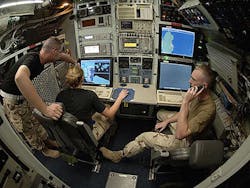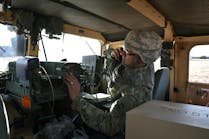Pentagon eyes 12.3 percent spending boost in electronics, communications, and intelligence
WASHINGTON – U.S. military spending in substantial electronics accounts is set for notable increases next year as spending increases are expected for procurement and research in military communications, electronics, telecommunications, and intelligence (CET&I) technologies.
The U.S. Department of Defense (DOD) is asking Congress for $12.93 billion for CET&I procurement and research in the fiscal 2019 proposed DOD budget, which is up by $1.42 billion, or 12.3 percent, over the 2018 DOD request. DOD's 2018 spending request was released earlier this month. These accounts contained $15.1 billion as recently as fiscal 2012.
The DOD request for CET&I procurement and research does not include military activities with substantial electronics content, such as aircraft avionics, vetronics, and missile guidance.
When all of these additional DOD electronics-heavy accounts are added, Pentagon spending levels for military electronics and defense electro-optics next year could approach $137 billion, industry analysts believe.
The DOD's CET&I budget request for fiscal 2019, which begins next October, includes $9.83 billion for procurement, which is up by 18.36 percent from the Pentagon's 2018 request of $8.3 billion.
Related: 2019 DOD budget proposes $686.1 billion in military spending: largest Pentagon budget ever?
The proposed budget also requests $3.1 billion for CET&I research, development, test, and evaluation (RDT&E), which is down from the 2018 requested level of $3.21 billion.
Highlights of the Army's proposed CET&I 2019 procurement budget request include $469.1 million for tactical network technology modernization; $351.6 million for handheld manpack small form fit (HMS) radios; $213.8 million for commercial off-the-shelf (COTS) communications equipment; $88.3 million for communications security; $104.3 million for information systems; $276.8 million for installation information infrastructure modernization; $299.7 million for the Army Distributed Common Ground System; $153.6 million for night-vision devices; $297.8 million for the indirect fire protection family of systems; $431.4 million for Joint Battle Command-Platform (JBC-P); $327.3 million for counterfire radars; and $230.4 million for automated data processing equipment.
Highlights of the Navy's CET&I request include $318.2 million for fast attack submarine acoustic equipment; $294.7 million for the Fixed Surveillance System deep-sea sonar; $420.3 million for the AN/SLQ-32 shipboard electronic warfare system; $220.9 million for shipboard information warfare exploit; $423 million for the Consolidated Afloat Networks and Enterprise Services (CANES) program; and $113.9 million for the Navy multiband terminal.
Highlights of the Marine Corps CET&I request include $225 million for the Ground/Air Task Oriented Radar (G/ATOR); $124.8 million for command post systems; $73.8 million for intelligence support equipment; $87.1 million for Next-Generation Enterprise Network (NGE N); $124.8 million for command post systems; and $279.7 million for radio systems.
The Air Force CET&I request includes $114.4 million for communications security equipment; $114.8 million for air traffic control and landing systems; $205.4 million for the Air Force Physical Security System; $132.7 million for combat training ranges; $140.9 million for minimum essential emergency communications; $102.8 million for the Air Force Network (AFNet); $189.1 million for tactical communications and electronics equipment; and $169.4 million for base communications infrastructure.
Ready to make a purchase? Search the Military & Aerospace Electronics Buyer's Guide for companies, new products, press releases, and videos

John Keller | Editor
John Keller is editor-in-chief of Military & Aerospace Electronics magazine, which provides extensive coverage and analysis of enabling electronic and optoelectronic technologies in military, space, and commercial aviation applications. A member of the Military & Aerospace Electronics staff since the magazine's founding in 1989, Mr. Keller took over as chief editor in 1995.



